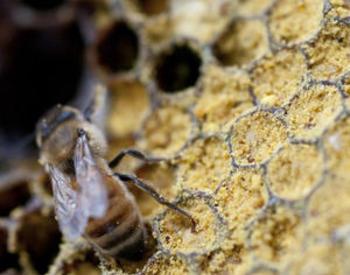CORVALLIS, Ore. – In a meadow high in the Cascades the rare and elusive western bumblebee flew into an old golden-mantled ground squirrel burrow, causing a stir among a group of scientists and conservationists gathered to find its nest.
Lincoln Best, faculty research assistant in the Oregon State University Extension Service’s Pollinator Health Lab in the College of Agricultural Sciences, quickly approached the burrow, sure he’d finally tracked it down.
“Foraging bees always return to the colony,” Best said. “We saw the bee within 20 minutes of arriving. We saw it fly down to the ground behind a rabbitbush and sure enough there were workers coming and going. We knew there was a colony there.”
The discovery allows Best and collaborators at Oregon Department of Forestry, Oregon Department of Fish and Wildlife and University of Oregon to research the western bumblebee (Bombus occidentalis) to help determine why it is disappearing and how to stop its measurable decline.
He and his colleagues dug until they got to the bottom of the burrow, hoping the nest was nearby. They weren’t so lucky. The burrow dropped like an elevator shaft, and they had to dig with pickaxes to follow it to the end, where they found a large, very heavy rock that had to be removed. Under the rock, the burrow ended. They were stumped until they cleaned out the ground squirrel tunnels with a shop vac, exposing a lateral burrow that led them six feet before ending at the squirrel’s hibernation den. Under it, protected by a layer of wax, was the western bumblebee colony.
“The basic strategy was to stick an arm down to shoulder deep into the burrow,” Best said. “We were hoping not to get bitten or stung or encounter a rattlesnake down there.”
The discovery inspired a plan to return to the site at the end of the season to excavate the nest from deep in the ground squirrel tunnels.
Best enjoys doing the important work of saving a native bee that was once a widespread and common species in the Pacific Northwest, pollinating native flora and helping preserve the ecosystem.
'Rare opportunity'
“It’s a rare opportunity to study the nest and colony of one of our more than 700 native bee species in Oregon, some of which are declining in distribution and abundance,” he said. “Finding their nest informs us about their biology and what they need to thrive. The western bumblebee has measurably declined in recent decades and has been proposed for Endangered Species Act listing. The U.S. Fish and Wildlife Service is currently working on a Species Status Assessment to determine if endangered status is warranted.”
Back in the Pollinator Health Lab on the OSU campus in Corvallis – where more than 150,000 bees are stored – Best took up tweezers to separate the 312 honey pots and brood cells from the colony one by one, measuring and labelling as he went. Examining the cells will tell him how many individual bees were produced in the colony and allow him to screen for pests and pathogens to get a handle on why the bee is disappearing.
“It’s amazing these bumblebees were nesting in a chamber that was several feet from the entrance, considering that once they went into the shaft it’s complete darkness,” said Best, who noted that bumblebees tend to make their nests in cavities more exposed to light. “They were coming and going and doing construction and maintenance in complete silence, too. It’s amazing to think about these bees living in that cavity.”
Best travels the state, as do the OSU Extension Master Melittologists he helps coordinate, searching for some of the hundreds of native bees in Oregon. The community science volunteers, all trained by Best and others, help document the bees in the state – many that have not been seen in years or ever.
The data, managed by Best, are included in the Oregon Bee Atlas, an initiative to document all of Oregon’s native bees. The Oregon Bee Atlas falls under the umbrella of the Oregon Bee Project, a statewide effort to safeguard the bees of Oregon. The Bee Project is a collaboration between OSU Extension, Oregon Department of Agriculture and Oregon Department of Forestry.
Best smiled as he bent over the nest he was dissecting, Finding the nest was something to celebrate.
“We were excited because it’s a rare finding,” he said. “Finding bumblebee nests in general is difficult. Finding a western bumble nest is extremely rare. We were lucky to find it.”



















